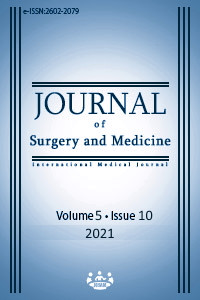The postoperative follow-up of varicose vein treatment with N-2-butyl cyanoacrylate application: A case series
Keywords:
N-2-butyl cyanoacrylate, Varicose vein, Treatment, Non-degradableAbstract
N-2-butyl cyanoacrylate application to varicose veins is a novel minimally invasive method for varicose veins. The non-requirement for tumescent anesthesia is the most advantageous feature of this method. However, the intravascular persistence of the administered substance after the procedure has not been evaluated. In this study, the intravascular persistence of N-2-butyl cyanoacrylate was evaluated in the 6th month of administration. Three cases who underwent great saphenous vein ablation treatment with N-2-butyl cyanoacrylate were included in the study. The early postoperative and midterm (6th month) Doppler ultrasonography results were compared. The venous reflux in the sapheno-femoral junction (SFJ) level was totally treated after N-2-butyl cyanoacrylate administration in all patients. Ultrasonography revealed fully filled N-2-butyl cyanoacrylate at the treated levels of the saphenous veins. Similarly, 6th month’s ultrasonography examinations revealed that N-2-butyl cyanoacrylate filled the great saphenous vein at the same level. It was observed that the rate of the vessel closed with N-2-butyl cyanoacrylate remained unchanged during six months. According to our results, intravenous N-2-butyl cyanoacrylate remains the same as at the time of administration without any degradation.
Downloads
References
Lee AJ, Robertson LA, Boghossian SM, Allan PL, Ruckley CV, Fowkes FGR, et al.Progression of varicose veins and chronic venous insufficiency in the general population in the Edinburgh Vein Study. J Vasc Surg: Venous and Lym Dis. 2015;3:18-26.
Lim CS, Davies AH. Pathogenesis of primary varicose veins. Br J Surg. 2009;96(11):1231-42. doi: 10.1002/bjs.6798.
Tabatabaeifar S, Frost P, Andersen JH, Jensen LD, Thomsen JF, Svendsen SW. Varicose veins in the lower extremities in relation to occupational mechanical exposures: a longitudinal study. Occup Environ Med. 2015;72(5):330-7. doi: 10.1136/oemed-2014-102495.
Almeida JI, Javier JJ, Mackay E, Bautista C, Proebstle TM. First human use of cyanoacrylate adhesive for treatment of saphenous vein incompetence. J Vasc Surg Venous Lymphat Disord. 2013;1:174-80.
Ronco V, Dard M. A novel suturing approach for tissue displacement within minimally invasive periodontal plastic surgery. Clin Case Rep. 2016;4(8):831–7.
Silverstein LH, Kurtzman GM. A review of dental suturing for optimal soft-tissue management. Compend Contin Educ Dent. 2005;26(3):163-6, 169-70.
Almeida JI, Javier JJ, Mackay EG, Bautista C, Cher DJ, Proebstle TM. Two-year follow-up of first human use of cyanoacrylate adhesive for treatment of saphenous vein incompetence. Phlebology 2015;30:397-404.
Proebstle TM, Alm J, Dimitri S, Rasmussen L, Whiteley M, Lawson J, et al. The European multicenter cohort study on cyanoacrylate embolization of refluxing great saphenous veins. J Vasc Surg Venous Lymphat Disord 2015;3:2-7.
Carriles YR, Brito RA, Sánchez RM, Acevedo ES, Domínguez PR, Mueller WD. n-Butyl cyanoacrylate synthesis. A new quality step using microwaves. Molecules. 2014;19(5):6220-7. doi: 10.3390/molecules19056220.
Singh PK, Degala S, Shetty S, Rai VS, Das A. To Evaluate the Efficacy and Effectiveness of N-butyl-2-cyanoacrylate glue (TRU SEAL) in Closure of Oral and Maxillofacial Laceration and Surgical Incisions. J Maxillofac Oral Surg. 2019;18(1):131-8. doi: 10.1007/s12663-018-1111-6.
Petrie ME. Cyanoacrylate Adhesives in Surgical Applications: A Critical Review.2014;2(3):253-310.
Downloads
- 414 387
Published
Issue
Section
How to Cite
License
Copyright (c) 2021 Erhan Hafız
This work is licensed under a Creative Commons Attribution-NonCommercial-NoDerivatives 4.0 International License.
















